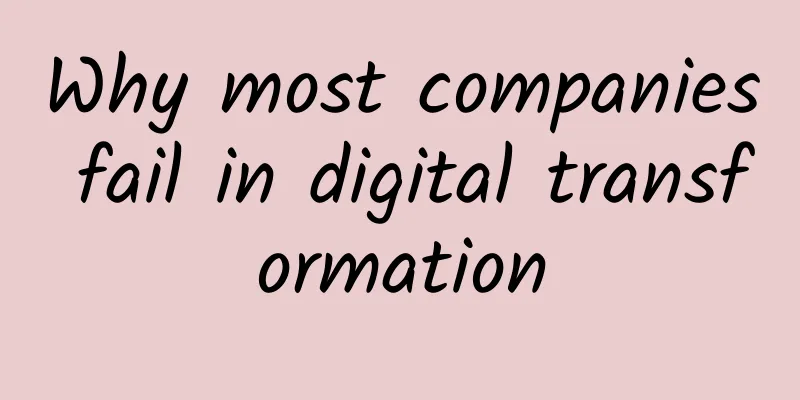Why most companies fail in digital transformation

|
I’ve said before that most digital business transformations fail. They do produce something, perhaps a new app, a more responsive website, or a digitally connected product that can be marketed as the “Internet of Things.” But the reality is that most digital project leaders don’t realize the transformational potential that digitalization can bring to their organizations. Here's why this problem occurs and how to fix it. Leadership doesn’t just belong to the CEO Digital business transformation requires goals, but such goals do not exist in isolation. This requires linking relatively empty corporate strategies to actions that can be implemented, such as adjusting the website platform or training employees. Nearly 1/3 of corporate CEOs told us that digital strategy is set by them personally. This is considered a good thing: the head of the company will be personally responsible for the digital strategy. But in reality, this is not the case. Only 21% of business managers said that their CEOs have set a clear digital strategy. When setting the overall strategic direction of the company, terms such as "multi-channel", "single channel" and "digital" are often overlapped, and always thinking about "Are we a single channel?" This question is not very helpful. You should pay more attention to what your customers want you to do. Take a look at eBay: eBay's design focuses on the most important thing, what users want. Digital business is not just an add-on Business leaders often don’t think of digital business as central because it never has been. Yet today, your customers, your products, your business operations, and your competitors are all digital in nature. 74% of business managers say their companies have a digital strategy, but only 15% believe their companies have the capabilities to execute on it. It is not enough to simply add digital channels or digital methods to existing operations in a piecemeal manner. Stop thinking about how to develop a separate digital strategy and think about how to digitize your corporate strategy. Look at companies like Airbnb and Uber that are designed for the digital age. Their business models are inherently mobile and social. They provide more than just great digital experiences, they are also working to achieve better digital operations and scale through expanded ecosystems. Yet, only 30% of business managers believe that digitalization will transform their business operations. Why? Because to them, digitalization is equivalent to apps and Apple Watches. They are missing the real opportunity for transformation. Previous technology experience does not predict digital business success The previous technical management process has constrained the ability to change. You still adhere to the outdated project approval process; your design and development methods still rely on a large number of requirement documents, but these documents have long lagged behind in the code writing process; you still use a development cycle of half a year, but in the process the gap between you and your competitors is getting bigger and bigger. The digitization of your business means that your business model, user experience, and technical design will be more closely integrated. Therefore, you must change the way you design, develop, and release your platform in the future. If you think, “We’re not a startup, we can’t do this,” you’re completely wrong. Look at companies that have gone digital at scale, like PayPal, Netflix, and Spotify, and they’ve challenged your perceptions. Even if it’s not obvious on the surface, these companies are already changing old systems and ideas and starting to transform themselves. You’re going to face cultural challenges, and just deploying some new technology isn’t really the answer. Do you think you know all the answers? It’s become a truism that the customer is always right. So why do so many business leaders think they have all the answers? Why do only 41% of companies measure metrics like Net Promoter Score? And why do only 11% use them systematically and effectively to guide investment decisions? Managers have pet projects and tendencies in technology management, and technology teams often make decisions based on vendors, past experience, and “is it cool?” Arrogance, corporate politics, and a lack of true understanding of customers prevent companies from moving fast. So when a bank starts looking at how to deliver products quickly and innovate with a customer focus, we can all learn something from it. Spain's CaixaBank uses open innovation to get ideas, prioritizes innovations that can bring value to customers, and gives the digital team sufficient resources and autonomy to enable them to develop their own projects. So what is the effect? The bank has achieved systematic innovation and continues to deliver new or optimized digital services to users. Digitalization is rewriting the rules of business. For industries like media, the change is happening now. For industries like utilities and pharmaceuticals, the change is coming. No industry is immune. You need to know when this trend will affect you and how you can prepare. The good news is that most companies’ top executive committees see the opportunities and threats that are coming at the same time. The bad news is that most executive teams don’t know what to do about it. At Forrester, we’ve seen a shift in our conversations with C-level executives over the past 18 months. In the past, we often get the question: “Does the digital revolution threaten our business?” Today, the more common question is no longer “What should we do?” but “How can we accelerate the pace of change?” I will present my views in my keynote at the TNW Europe Conference. We have worked with dozens of companies to crack the code of digital strategy, and one common experience has emerged: The way organizations have traditionally planned and managed large-scale change is no longer fit for purpose. We need a new approach. One that is iterative, customer-centric, agile, integrated with your digital strategy, easily understood by all stakeholders, engaging, and responsive to the changes we cannot avoid. As a winner of Toutiao's Qingyun Plan and Baijiahao's Bai+ Plan, the 2019 Baidu Digital Author of the Year, the Baijiahao's Most Popular Author in the Technology Field, the 2019 Sogou Technology and Culture Author, and the 2021 Baijiahao Quarterly Influential Creator, he has won many awards, including the 2013 Sohu Best Industry Media Person, the 2015 China New Media Entrepreneurship Competition Beijing Third Place, the 2015 Guangmang Experience Award, the 2015 China New Media Entrepreneurship Competition Finals Third Place, and the 2018 Baidu Dynamic Annual Powerful Celebrity. |
>>: Xiaomi: A department store disguised as a phone manufacturer
Recommend
A well-known singer used hair testing to prove his innocence. Why is hair testing called the "magic mirror" for drug-related personnel?
Drug use is illegal in our country, but when it c...
Planning a trip during the holidays? Here is a guide to outdoor activities safety
More and more people Pursue the fun and excitemen...
All-round home entertainment center Laura Unicorn home entertainment host first review
Previously, we brought you the first preview of t...
Review of marketing cases in Q1 2022!
In a blink of an eye, three months have passed in...
Event Operations: How to conceive event ideas?
I once had a colleague who switched from another ...
How to improve the effectiveness of information flow advertising by making good use of pictures?
We all know that it is not easy to make a success...
Examples of optimal materials for information flow advertising to help you improve your conversion rate!
We have selected and compiled some information fl...
Why do some people get diarrhea when they are nervous?
Planning and production Source: A Brief History E...
The strong dragon cannot defeat the local snake. Google's return to China is doomed to be a tragedy.
[[155934]] Recently, it is said that Google inten...
Why is radar called the "clairvoyance" in modern warfare?
Radar is a device that uses electromagnetic waves...
Teacher Wang Fan can use common sense to understand financial statements, and everyone can learn stock investment skills
Follow teacher Wang Fan, who has 9 years of pract...
Fitness apps are actually useless for fitness, except for chatting with each other...
Every fitness app claims that the best mobile coa...
New power grid, all relying on "wind and solar"? Unveiling the new power system
In your life, are you promoting such behaviors th...
Which industries are Xiaohongshu’s information flow ads suitable for?
In my country, there are more than 400 million fe...
How to synthesize gold medals in Kuaishou? How to synthesize gold medals in Kuaishou Olympic events
This article mainly introduces relevant informati...









